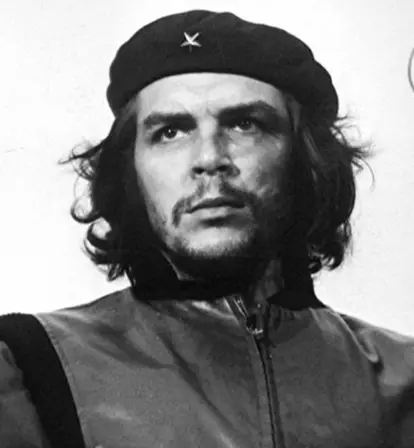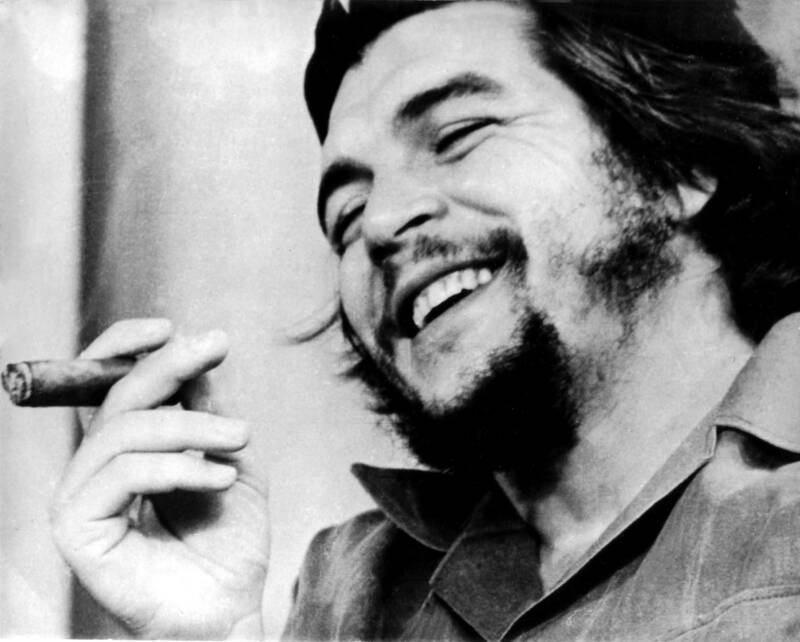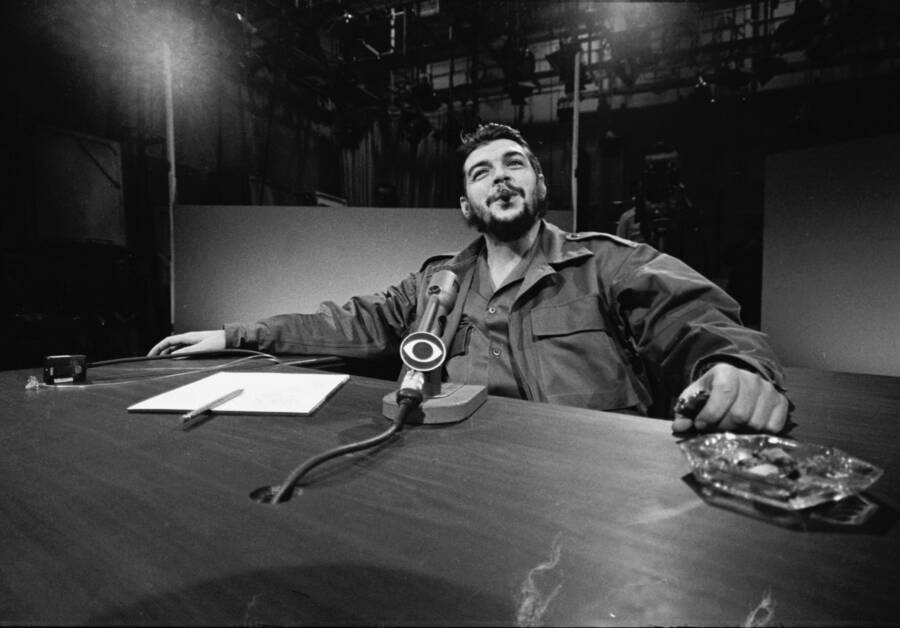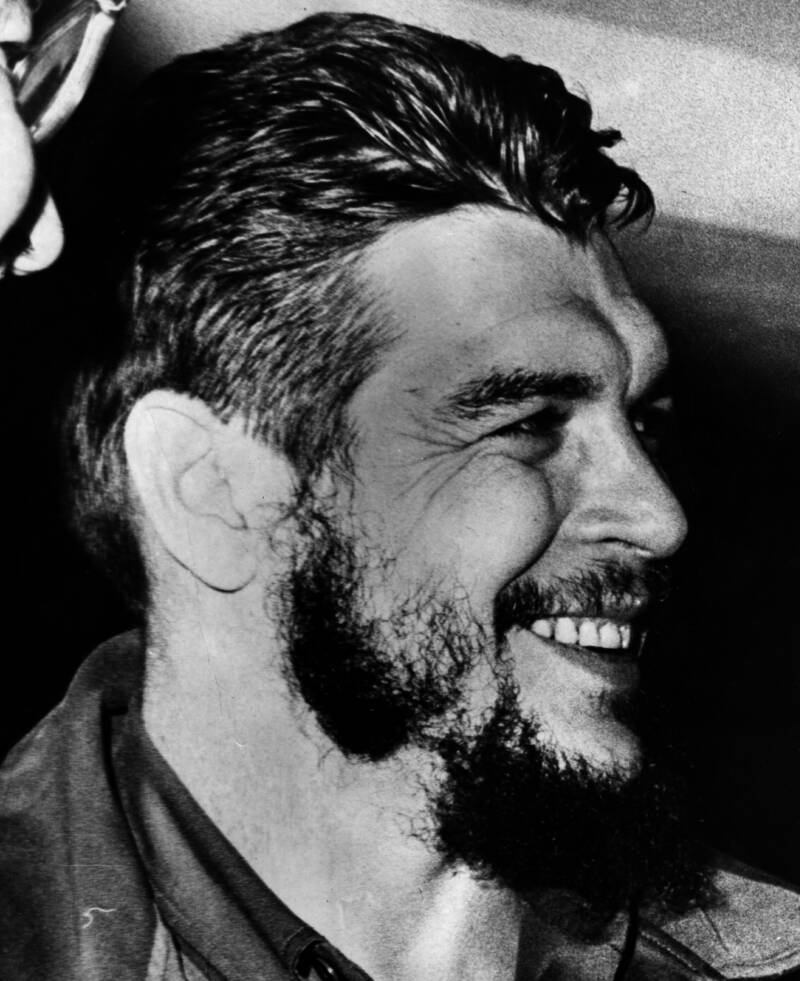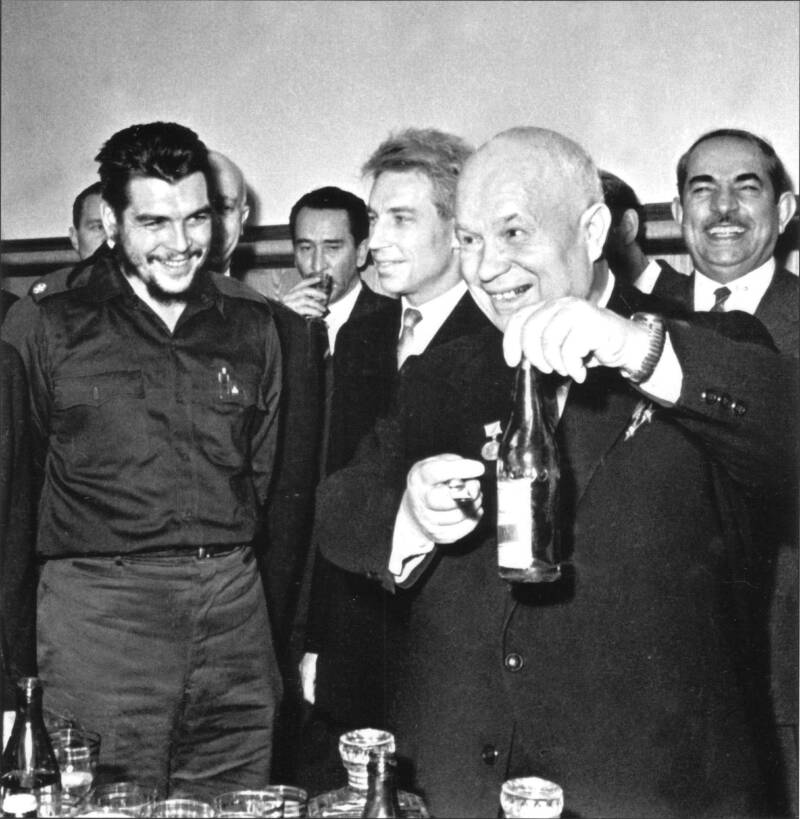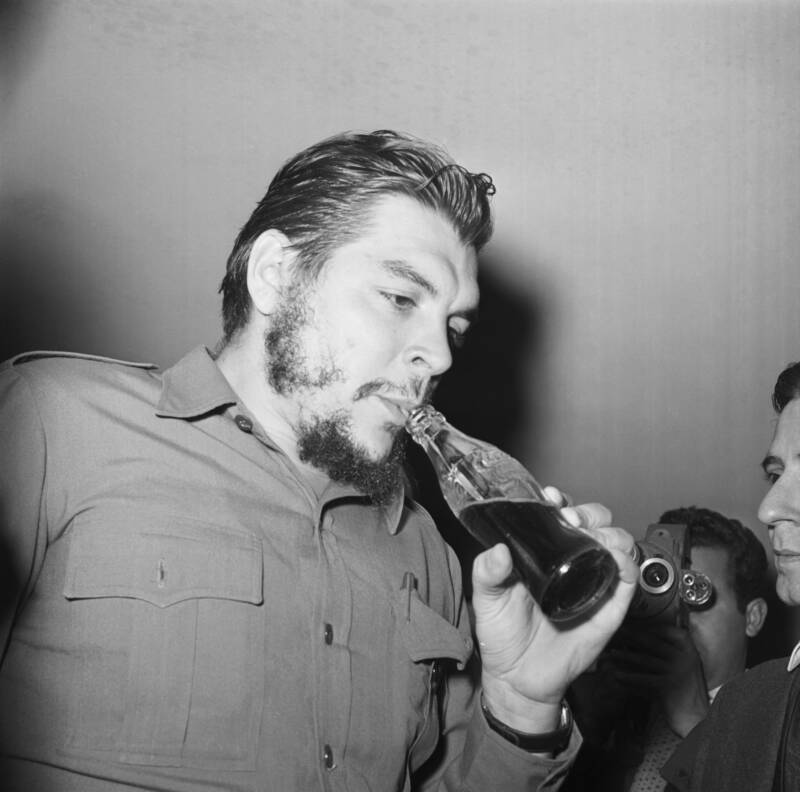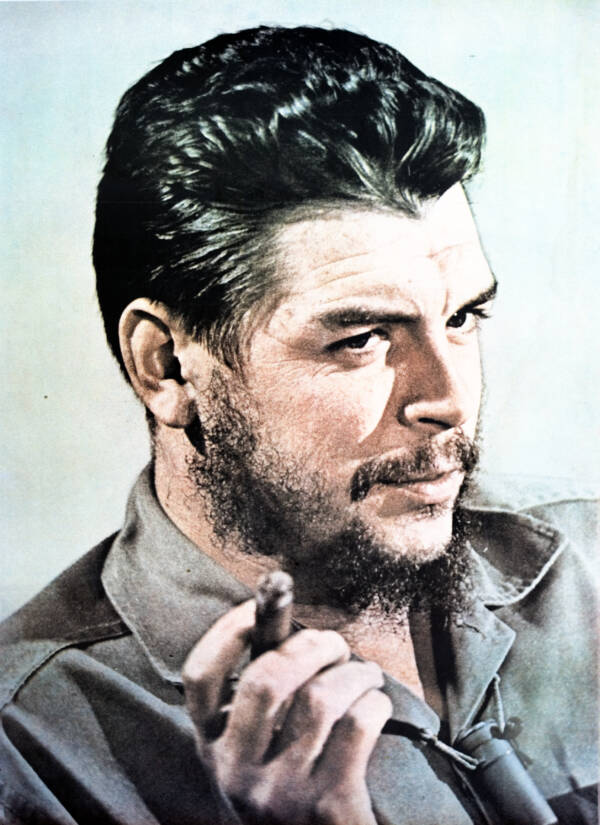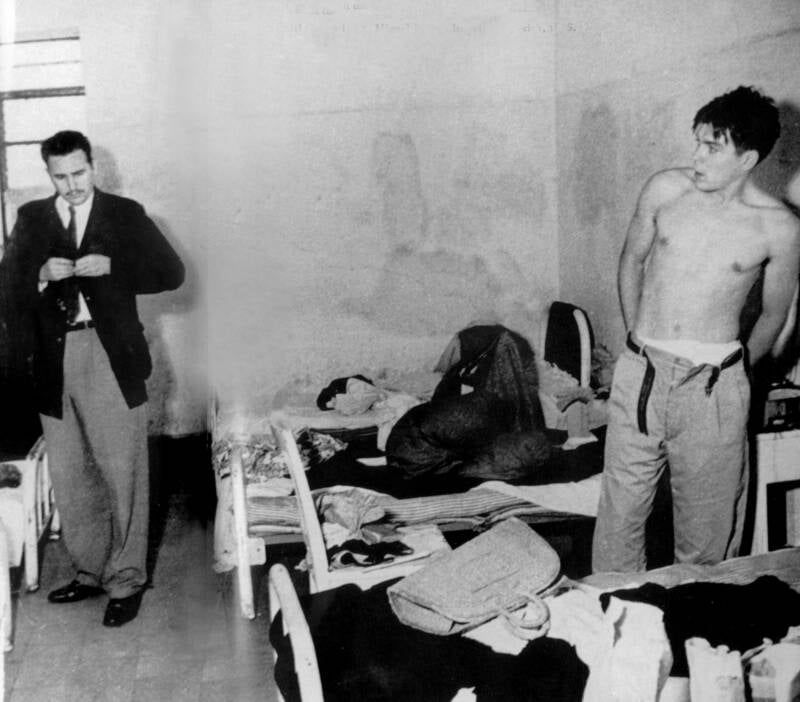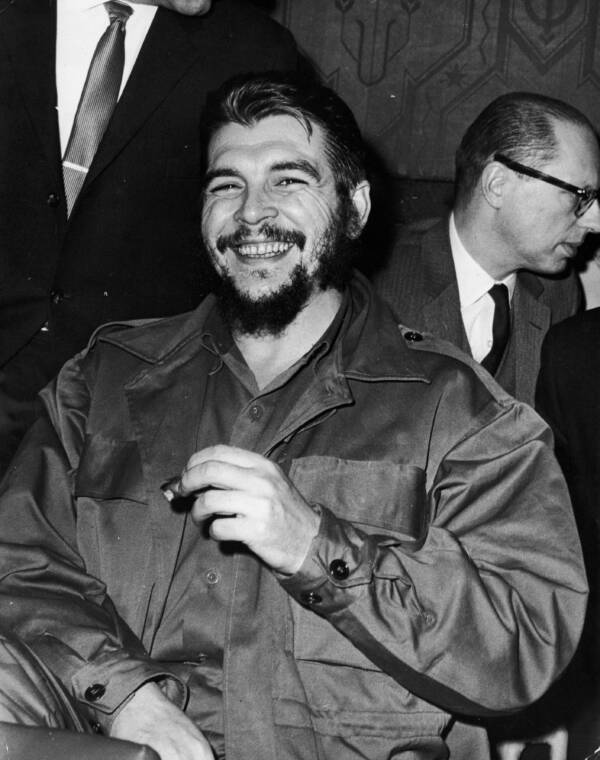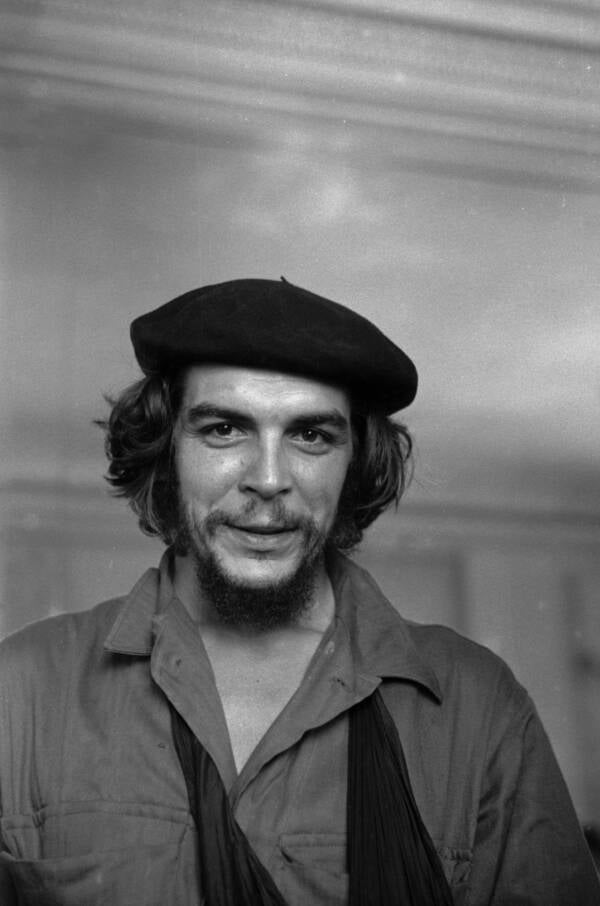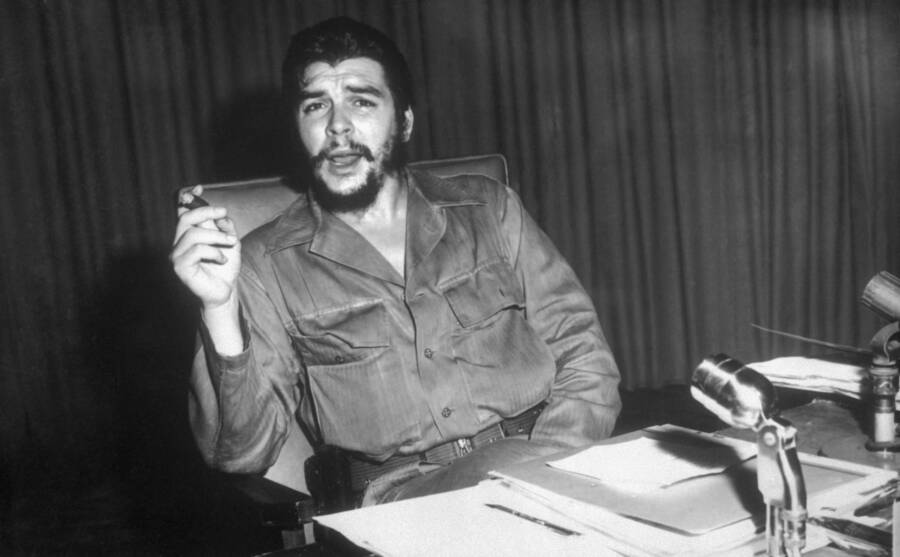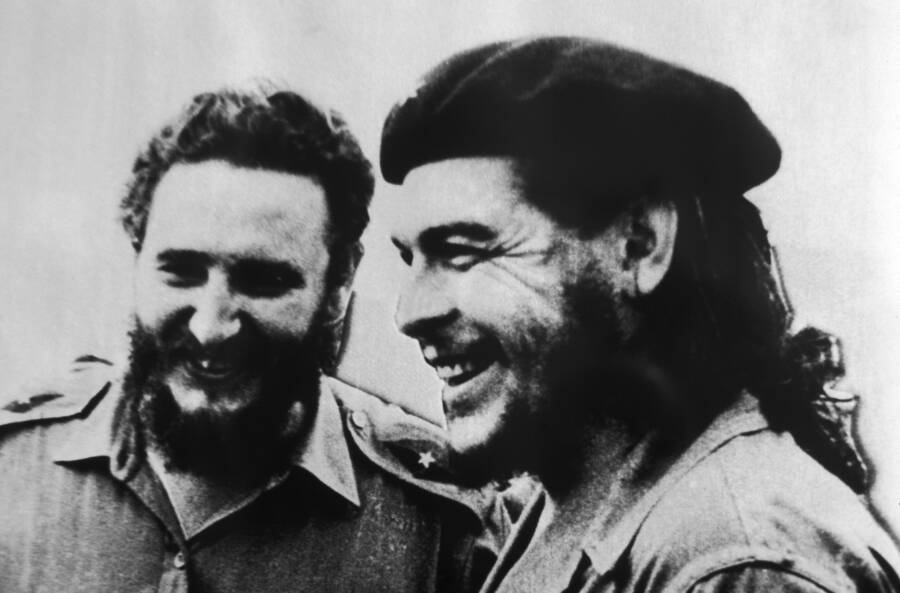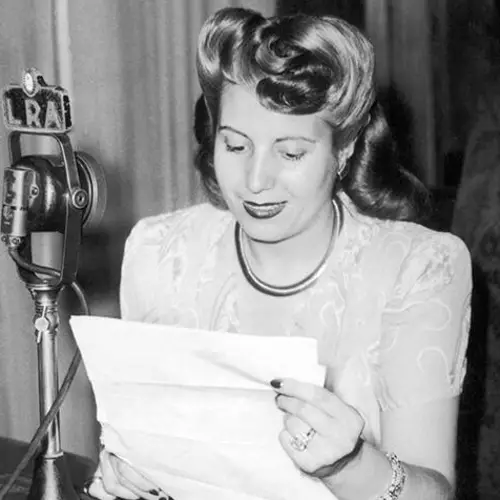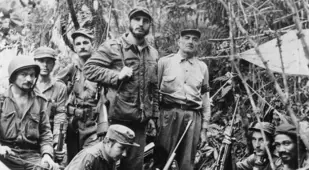Today, Ernesto "Che" Guevara is an undying symbol of revolution. But was he a hero or a monster?
Today, Ernesto “Che” Guevara is a popular symbol of rebellion and counterculture. He is the intense face, gazing upward toward the future, atop a sea of red that we have seen so many times on posters, graffiti, and t-shirts.
To many, he is a hero: a figure to be idealized, whose every word is worth pouring over. But to others, he’s a cold-blooded killer: a violent, brutal tyrant who helped spread a dangerous breed of socialism.
But before he became a historic symbol, Ernesto “Che” Guevara was a man. He was neither perfect nor an irredeemable monster. He was a flawed human being, working to create his vision of the world informed by his own beliefs and ideals.
This is his story.
A Determined Young Man

Apic/Getty ImagesA young Che Guevara during his days as a medical student. Argentina. Circa 1950.
On Dec. 10, 1953, Ernesto “Che” Guevara sent his Aunt Beatriz a note, telling her he had sworn on the photograph of the recently-deceased Joseph Stalin: “I won’t rest until I see these capitalist octopuses annihilated.”
These “capitalist octopuses” were the United States and its huge corporations, like the United Fruit Company, which were known to exploit workers in Latin America so wealthier countries could eat cheap bananas. Guevara saw their corrupt power first-hand when he traveled through five South American countries on a motorbike as a medical student in 1950.
By the time he penned his letter, however, Ernesto Guevara found himself in Guatemala in the middle of a U.S.-backed coup d’état – an experience destined to change his life forever.
Che Guevara In Guatemala
Under the orders of President Dwight D. Eisenhower, U.S.-backed rebels invaded Guatemala, bombed its capital, and broadcast anti-government propaganda in a concentrated effort to overthrow the country’s democratically elected president, Jacobo Árbenz.
Árbenz had been redistributing land to the poor — by 1952, he had seized 225,000 acres from wealthy landowners and large corporations — a program that affected the American-based United Fruit Company more than anyone else in the country.
Guevara — like many others — was convinced that the entire coup was an American scheme to support UFC’s business interests. And he was right: John Foster Dulles, then the U.S.’s secretary of state, was a former lawyer for UFC, and his brother was on the company’s board of directors.
The multinational corporation, whose annual profits were twice the annual revenue of the government of Guatemala, spent loads of cash lobbying the U.S. government to intervene and protect the company’s interests.
Che Guevara was determined to help. He joined the Communist Youth League and tried to rally the people of Guatemala to resist. Twice he volunteered to fight — but few could match his revolutionary fervor, and Guevara found himself full of fury but in an army unwilling to let him act upon it.
Less than seven months after Guevara sent that letter, Guatemala fell. Árbenz resigned, the U.S.-backed dictator Carlos Castillo Armas took power, the United Fruit Company’s land was returned, and the new military began actively rounding up and executing suspected communists.
Before long, Guevara had no choice but to flee the country and hide out in Mexico.
Guevara had failed to change Guatemala, but Guatemala changed him. In exile in Mexico City, he would meet the revolutionary leader that would help him change the world.
Meeting Fidel Castro
Fidel Castro, in Guevara’s eyes, was a man worth dying for. He was, in many ways, like Árbenz: a man willing to risk everything to help the poor pitted against a dictator backed by the United States.
The pair was introduced by Cuban exiles Guevara had met in Guatemala, and on the first meeting they spent 10 hours talking about revolution, reform, and the future of Latin America.
Castro was exactly what Guevara was looking for. By sunrise, he’d already joined his band of rebels.
“To tell the truth,” Che Guevara later wrote in his journal, “after my experiences across Latin America I didn’t need much more to enlist for a revolution against a tyrant.”
The Cuban Revolution
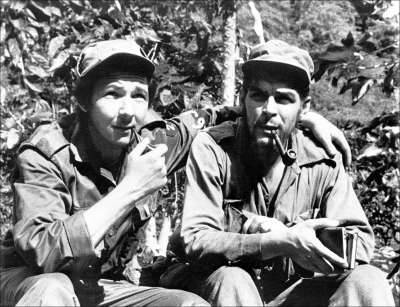
Wikimedia CommonsRaul Castro, left, younger brother Fidel, has his arm around second-in-command, Ernesto “Che” Guevara in their Sierra de Cristal Mountain stronghold south of Havana, Cuba, during the Cuban revolution. June 1958.
On Nov. 25, 1956, the men of Castro’s revolution — the 26th of July Movement — set off for Cuba. It wouldn’t be long, however, before Guevara would learn just how brutal war could truly be.
Almost immediately after getting off the boat, their small band was attacked by the troops of Fulgencio Batista, Cuba’s U.S.-backed dictator. Only 22 of them survived, scattered across the Cuban jungle, and over the next few days, the few left would have to struggle to find each other again.
Perhaps it was that brutal welcome that turned Guevara into the cold, ruthless soldier he became — a far cry from the doctor-in-training providing free medical care to an Amazonian leper colony. Quickly, Guevara gained a reputation as stern and demanding, a man who wouldn’t hesitate to kill.
His own writings support this view. Describing a moment when a brother-in-arms was accused of treason, Guevara wrote: “The situation was uncomfortable for the people…so I ended the problem by giving him a shot with a .32 pistol in the right side of the brain.”
But a ruthless warrior was exactly what the Cuban revolutionaries needed. With Guevara’s help, the band of 22 men set up a propaganda radio station, built up supporters, and managed to whittle down Batista’s army with guerrilla hit-and-run warfare.
Che Guevara was soon made Castro’s second-in-command and given a column of his own. He would lead them through the decisive moment of the war: the Battle of Santa Clara.
On December 31, 1958, Guevara captured the city alongside Camilo Cienfuegos — another of Castro’s lieutenants — after a seven-week-long march. When news of Guevara’s victory reached Batista, he fled the country. Cuba had fallen into Castro’s hands.
Guevara And Castro Against The U.S.
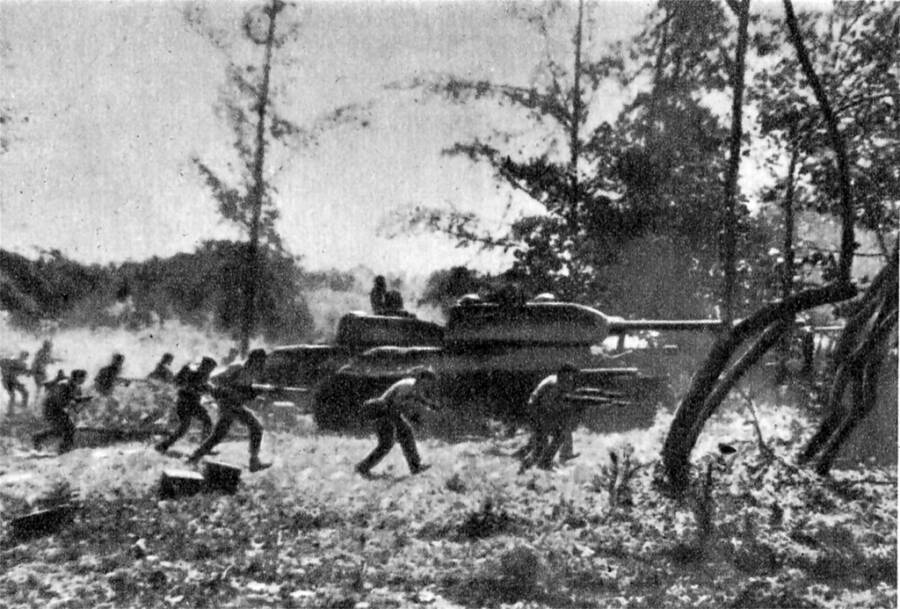
Wikimedia CommonsThe Bay of Pigs Invasion. April 19, 1961.
Cuba, under Castro, was a nation changed. Income inequality was drastically lowered. Housing, healthcare, and education alike were reworked, and the impact was incredible. The nation, which had once been only 60 percent literate, skyrocketed up to a 96 percent literacy rate under Castro’s reforms. From January to December of 1961, more than 700,000 Cuban adults were taught how to read and write.
But there was no denying the decidedly Marxist approach Castro and Guevara had followed to achieve their ends.
Factories, banks, and businesses alike were nationalized, and Guevara — likely following the lead he’d seen in Guatemala — penned a law redistributing large farms and foreign-owned sugar plantations to the poor — including some 480,000 acres of land owned by American corporations.
It didn’t sit well with the United States. Eisenhower tried to strike back economically, reducing U.S. imports of Cuban sugar in the hopes of financially bullying Castro into submission. When Castro didn’t back down, he took harsher measures.
On March 4, 1960, La Coubre, a French freighter carrying 76 tons of grenades and munitions, exploded in Havana Harbor, killing up to 100 people. Guevara was on the scene; he personally rushed toward the explosion and tended to the wounded.
The attack, Castro would later insist, had been orchestrated by the CIA, and more were coming.
America, Guevara believed, was terrified of what Castro represented. “The North Americans are aware…that the victory of the Cuban Revolution will not be just a simple defeat for the empire,” Guevara told the people of Cuba a few weeks after the explosion. “It will mean the beginning of the end of colonial domination in America!”
The Bay Of Pigs Invasion
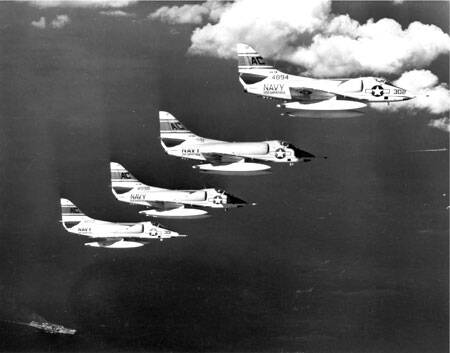
Wikimedia CommonsU.S. aircraft fly over the Caribbean during the failed Bay of Pigs Invasion. April 1961.
Days after he made that speech, an army of Cuban exiles — trained, funded, and supported by the CIA — invaded the country while American planes dropped bombs overhead.
But Cuba was ready for them. As Che Guevara had warned: “All of the Cuban people must become a guerrilla army; each and every Cuban must learn to handle and if necessary use firearms in defense of the nation.” And true to his orders, the people of Cuba were ready to fight off the invaders.
The Bay of Pigs invasion lasted only four days. It was such a complete and total failure that, when the fighting ended, Guevara sent John F. Kennedy a thank-you letter:
“Thanks for Playa Girón [Bay of Pigs]. Before the invasion, the revolution was weak. Now it’s stronger than ever.”
It was a huge embarrassment for the U.S. that ended up strengthening, rather than weakening, its communist rivals in Cuba.
The Cuban Missile Crisis
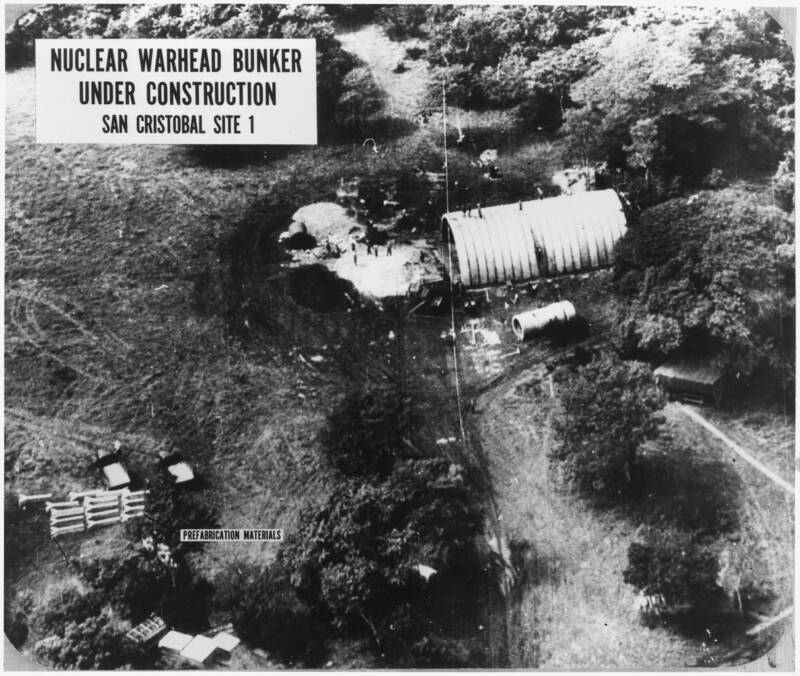
Department of Defense/National ArchivesA nuclear warhead bunker under construction in San Cristobal, Cuba during the Cuban Missile Crisis. October 1962.
The Bay of Pigs convinced Guevara that America was his chief enemy. In its wake, he became the nation’s most vicious critic.
The U.S. was no democracy, he said directly to the American government officials gathered in Uruguay on Aug. 8, 1961 at the Inter-American Economic and Social Council.
“Democracy,” he argued, “is not compatible with financial oligarchy, with discrimination against Blacks and outrages by the Ku Klux Klan.”
America feared Cuba, he insisted, because they were a guiding light for the nations of South America to follow; an example that would inspire them to overthrow their imperial American oppressors. He called on South American countries to fight them at any cost.
“The possibility of the peaceful road is almost non-existent in the Americas,” Guevara argued. “The blood of the people is our most sacred treasure, but it must be used.”
There were no limits to how far Guevara was willing to go. In 1962, he played a key role in getting Soviet nuclear missiles into Cuba. In the Cuban Missile Crisis that followed — the closest the world ever came to nuclear war after World War II — the U.S.S.R. would eventually agree to remove the missiles. But this didn’t stop Guevara from proudly proclaiming that he was ready to use them.
“If the rockets had remained,” Guevara told a British newspaper, “we would have used them all and directed them against the very heart of the United States.”
Judge And Executioner
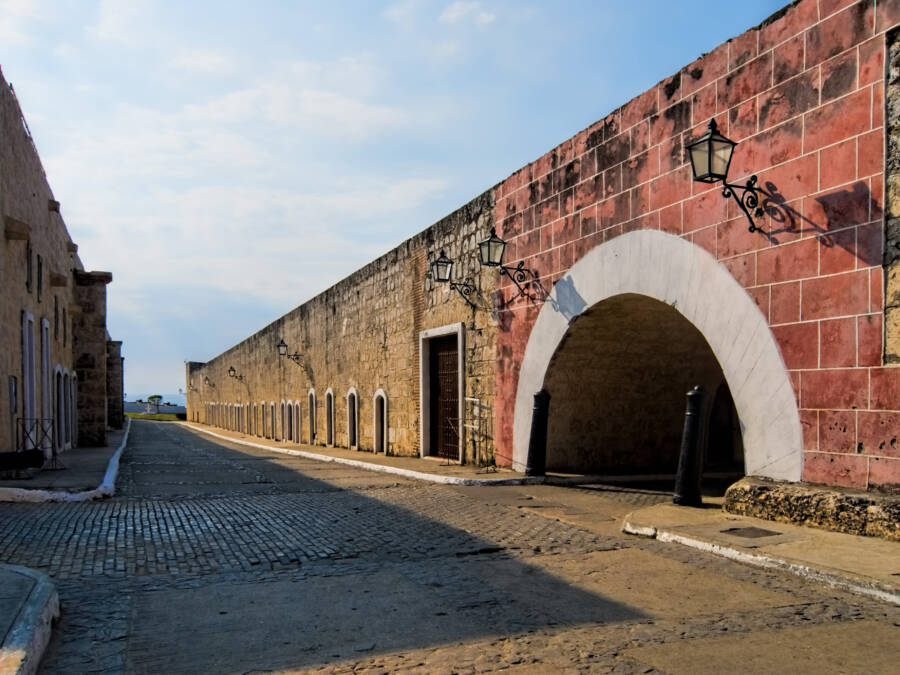
Dan Lundberg/FlickrLa Cabaña Fortress, built by the Spanish in the 18th century, is where Fidel Castro put Che Guevara in charge in the first five months after the Cuban Revolution.
Ernesto “Che” Guevara didn’t spend his entire Cuban tenure sticking it to the United States. In fact, his first job was to root out military dissidents by any means necessary.
Shortly after Castro’s victory over Batista, Cuba’s new leader put Guevara in charge of La Cabaña Fortress, a prison on the eastern bank of the entrance to Havana Harbor. It was Guevara’s job to oversee the tribunals and sentences of Batista’s captured soldiers.
In the months after the 26th of July Movement’s victory, hundreds of political prisoners were killed. It’s estimated that Guevara himself oversaw between 55 and 105 of these executions.
Decades later, journalist James Scott Linville recalled a story his former boss, Paris Review editor George Plimpton, told him about a visit to Cuba just after the revolution:
“After he arrived in Havana, he settled in at a hotel room above a bar. One afternoon, at the end of the day, [Ernest] Hemingway told him, ‘There’s something you should see,’ and to come by the house. When he arrived at Hemingway’s house he saw they were preparing for some sort of expedition….This group, including a few others, got in the car and drove for some time to the outside of town.
Arriving at their destination, they got out, set up chairs, brought out the drinks, and arranged themselves as if they were going to watch the sunset. Soon enough, a truck came….It came, as Hemingway explained to them, the same time each day. The truck stopped and some men with guns got out of it. In back were a couple of dozen others who were tied up. Prisoners. The men with guns hustled the others out of the back of the truck and lined them up. And then they shot them. They put the bodies back in the truck and drove off.”
“The executions by firing squad,” Guevara wrote of Feb. 5, 1959, “are not only a necessity for the people of Cuba, but also an imposition by the people.”
Whatever would protect and ensure the success of the revolution, in other words, Guevara would do.
Attempts On Che Guevara’s Life
On Dec. 11, 1964, Ernesto “Che” Guevara was invited to speak before the United Nations in New York — the largest city of his biggest enemy. Despite the obvious danger, Guevara accepted. Standing before the leaders of the world, he didn’t mince a single world.
“Colonialism is Doomed” was the name of his speech, and in it, he called Americans “those who kill their own children.”
“This great mass of humanity has said, ‘Enough!’ and has begun to march,” he proclaimed in his speech. “This world is beginning to tremble. Anxious hands are stretched forth, ready to die for what is theirs.”
Two separate attempts were made on his life before he got out of the building. The first was by a woman named Molly Gonzales, who rushed at him with a seven-inch knife.
The second was by a man named Guillermo Novo, who fired a bazooka at the UN building from across the East River. Fortunately for Guevara, the rocket failed to reach the building, detonating in the water 200 yards short of its target.
Guevara, however, was unfazed by it all, joking with a cigar in his mouth that the attempt had just “given the whole thing more flavor.”
Che Guevera And A Global Revolution
His sights were no longer just set on Cuba. By this point, Che Guevara saw himself as a man destined to tear down imperialism and bring about Marxist revolution in every part of the globe.
As he'd promised his aunt years ago, he wasn't going to rest until the "capitalist octopuses" had been completely annihilated.
In line with his newfound global mission, Guevara gave a speech on February 24, 1965 in Algeria, calling on the people of Africa and Asia to join in the Marxist struggle: "There are no borders in this struggle to the death."
But Guevara went too far when he started criticizing the one ally Cuba truly needed: the Soviet Union.
During the speech, he called the Soviet Union an "exploiter," described their New Economic Policy as "the great Trojan Horse of Socialism," and declared that the Soviets were "failing because they have forgotten Marx."
When Guevara returned to Havana in March 1965, Castro reportedly chewed him out. For hours, it's said, Castro could be heard bellowing at Guevara through the walls of the "security house" where he forced him to stay. When Guevara finally left after nearly two straight days of talking, he looked like a defeated man.
"I had never seen him like this," one witness recalled. "He looked miserable."
Leading Armed Revolution In Congo And Bolivia
Che Guevara left Cuba shortly afterward. He left one final letter to Fidel Castro, in which he wrote:
"I feel that I have fulfilled the part of my duty that bound me to the Cuban Revolution....I formally renounce my posts in the leadership of the Party, my post as Minister, my rank as Major, my status as a Cuban citizen. Nothing legal binds me to Cuba."
Whether he'd left at Castro's command or of his own will is a matter of debate, but Guevara would never have a role in Cuban government again.
Instead, he went abroad, joining in socialist revolutions around the world. His first trip took him to the Congo, where he fought against the military dictator Mobutu Sese Seko, who took power with the support of the CIA.
That fight failed, and Guevara returned to South America to help aid the revolutionary struggle in Bolivia.
There, he raised a guerrilla army of his own to fight against President René Barrientos, who had taken power in an U.S.-supported coup.
Once more, however, Guevara was unable to accomplish the kinds of victories he had in Cuba. He struggled to get the support of other dissidents and, in August of 1967, suffered a major defeat when the Bolivian Army managed to ambush and eliminate two of his guerrilla groups.
As it happens, the U.S. had provided Barrientos with CIA Special Activities Division commandos, Special Forces, and Rangers to help crush Guevara's insurgency.
The whole force was trained and led by Félix Rodriguez, a former Batista loyalist who'd fled Cuba during the revolution and joined the CIA.
On Oct. 8, 1967, his team succeeded in capturing the wounded revolutionary. Although Rodriguez wanted to keep Guevara alive for questioning, Bolivia's president ordered his immediate execution.
The Death Of Che Guevara
Wikimedia CommonsChe Guevara's boots shortly after his execution. October 9, 1967.
Before he killed him, Rodriguez dragged Guevara outside and had his men take pictures of him, gloating over his captured enemy. Then, he sent one of his men in to kill him in a way that made it look like Guevara died in battle.
"I know you've come to kill me," Guevara said, according to legend, as he stared his executioner in the eyes. "Shoot, coward! You are only going to kill a man."
"Guevara was executed," CIA Director Richard Helms reported to the secretary of state and other U.S. officials after the deed was done.
The U.S. had wanted to keep him alive, declassified documents show.
But the government wasn't too upset; National Security Secretary Walter Rostow wrote that is was a "stupid" but "understandable" mistake before boasting that Guevara's death showed the "soundness of our 'preventive medicine' assistance to countries facing incipient insurgency." It was American-trained Bolivians who got him, after all.
The man had been killed — but, as he warned with his final words, the idea of Che Guevara could never be.
Che Guevara Is Immortalized In Guerrillero Heroico
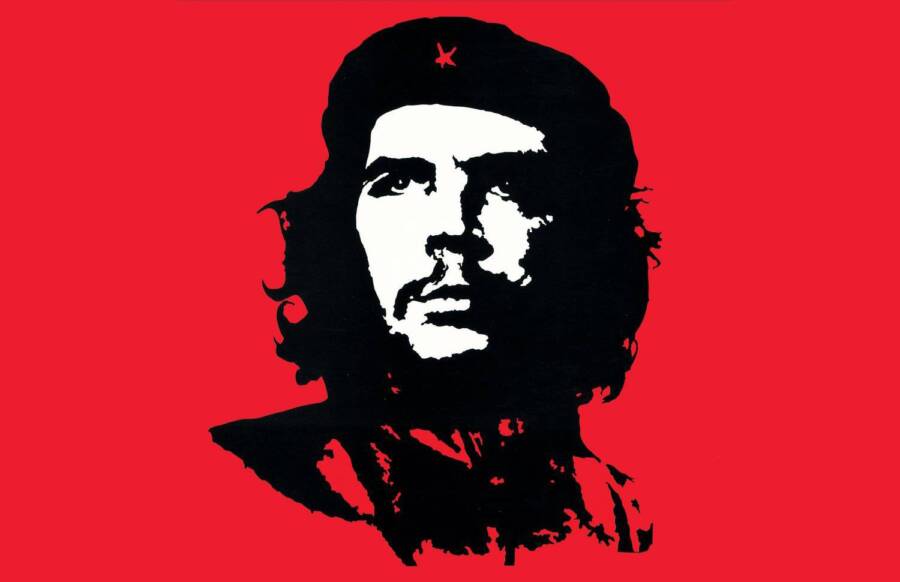
Wikimedia Commons"Guerrillero Heroico," the famous stylized image of Che Guevara created by Jim Fitzpatrick off of an photograph by Alberto Korda.
In Cuba, Castro proclaimed three days of mourning for his fallen comrade, telling his people: "If we wish to express what we want the men of future generations to be, we must say: 'Let them be like Che!'"
Meanwhile, around the world, Guevara quickly became the symbol of standing up against the powers that be.
After learning of Guevara's death, British artist Jim Fitzpatrick took an existing photograph of Guevara and made a stylized, red-black-and-white image of him that he spread as far and as wide as he could.
"I thought he was one of the greatest men who ever lived," Fitzpatrick would later explain. "I felt this image had to come out, or he would not be commemorated otherwise, he would go where heroes go, which is usually into anonymity."
Chea Guevara was not forgotten. Fitzpatrick's image was spread around the world in countless iterations, showing up on posters, graffiti, t-shirts, and album covers.
They'd killed the man, but never the idea. To this day, Ernesto "Che" Guevara lives on as a symbol of rebellion, socialism, and communism recognized in every part of the world.
But nowhere is he remembered more fondly than in Cuba, the country whose history he changed forever.
Even decades after his death, the school children in Cuba begin each Friday morning by pledging: "Pioneers for communism, we will be like Che!"
After learning about Che Guevara, learn more about the Cuban Revolution and the CIA's plots to assassinate Fidel Castro.
